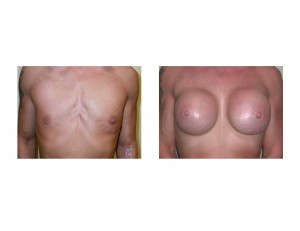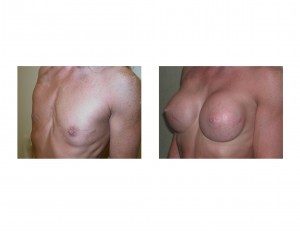Background: Body builders and figure enthusiasts create chest and arm muscular volume and definition by cutting fat and inducing muscular hypertrophy. But what differentiates male and female bodybuilders from a chest standpoint is that females should have a breast mound while men are flat. But due to the regimented stripping of fat as part of their training regimens, many female body builders lose most if not all of their breast mounds.
Breast augmentation in body builders always brings up the issue of the pectoralis muscle and how it will be affected by the surgery. Should the implant go above or below the muscle? Will it decrease muscle function and strength afterwards in any way? How long will working out be delayed?
Placing breast implants above the muscle (subglandular augmentation) would seem to be the most logical implant position given that there would be no interference whatsoever with pectoralis muscle function. Such implant positioning, however, has been shown to have more long-term complications such as implant show, rippling and capsular contracture. Using textured silicone implants, possible even shaped ones so they do not look too round, is a reasonable option. In most cases, it is essentially a skin over an implant result.
Conversely, clinical studies have shown that subpectoral breast implants do not have long-term muscle weakening effects. There is some short-term muscle weakness but that generally fully recovers by 6 to 12 weeks after surgery. An inframammary incision is preferred over a transaxillary approach due to less muscle elevation and a quicker recovery.
Case Study: This 29 year-old female was an avid figure body builder who had lost all of her breast tissue. She already had lost some due to having children and working out vigorously and dropping weight took care of what was left.


Submuscular breast augmentation can be done successfully in weight lifting and fitness enthusiasts. It does not affect the function of the pectoralis muscle and this undoubtably because it is in the dual-plane. In the dual plane location the pectoralis muscle is really partially draped over the implant and its excursive range is unaffected. This makes for no alteration in muscle function beyond the first few weeks due to some discomfort.
Case Highlights:
1) Many female bodybuilders can lose most of their breast tissue due to cutting weight.
2) Subpectoral dual plane breast augmentation can be safely done without any long-term negative influence on weight lifting regimens.
3) With little breast tissue cover, the profile of the breast implants is often fairly discernible.
Dr. Barry Eppley
Indianapolis, Indiana


